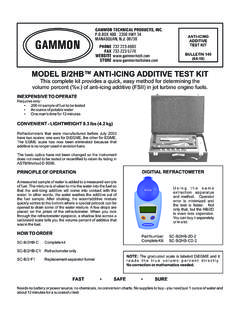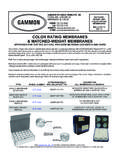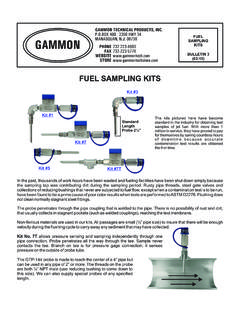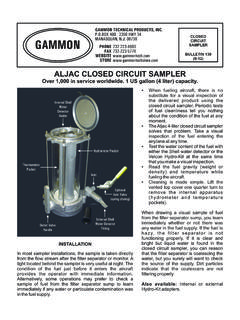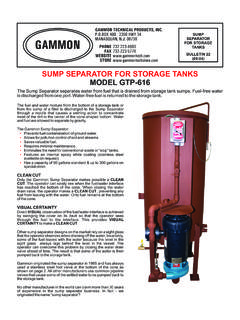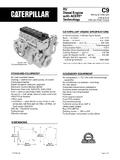Transcription of DETECTING WATER IN AVIATION FUEL SYSTEMS - …
1 THE GAMGRAM. No. 63 DETECTING WATER IN AVIATION FUEL SYSTEMS APR. 2012. Most of our GamGrams mention WATER contamination from one perspective or another. But somehow, we never wrote on the detection of WATER in AVIATION fuel SYSTEMS . Obviously, no one wants WATER in their fuel supply system or aircraft; it doesn't burn and over time it can cause serious problems including micro-organism growth and corrosion - and it can plug filters and jam controls when it freezes. Even in a tropical environment, the air temperature at altitude is often below the freezing point of WATER , so WATER can freeze in flight anywhere. Aircraft can deal with a little bit of WATER , and they must do so because as fuel cools, WATER that was dissolved into it condenses out. Our job as fuel QC people is to minimize undissolved WATER in the fuel. HOW WATER GETS INTO YOUR SYSTEM - The most common way WATER gets into a fuel system is through condensation.
2 All air contains WATER (humidity) and air is constantly breathed into storage, transport and aircraft fuel tanks. When you pump a gallon or liter of fuel out of a tank, you draw in a gallon or liter of air to replace it. During a rain storm or in a humid environment, the problem can be much worse. Temperature changes in the tank from day to night then cause the WATER to condense from the air, inside the fuel tanks. Adding to this, the fuel contains WATER dissolved into it at very low levels, and as temperatures change, this WATER also condenses out as liquid. The amount of WATER that can dissolve into fuel varies with temperature, and can be as much as 90 ppm or more. As the fuel temperature drops, its dissolved WATER condenses out. In an aircraft, this can repeat every time the aircraft takes on more fuel or flies from warm air (near the ground) to cold air at altitude, and repeated cycles can generate quite a bit of WATER in the aircraft over time.
3 The same thing happens in your fuel supply system, but at a slower rate. When the fuel temperature goes up, a little WATER will dissolve back into the fuel, but most of the WATER remains in tank bottoms, filter sumps or lies in the bottom of the pipe, until there is so much that it gets downstream. We can also get WATER in our fuel SYSTEMS from mishandling and equipment failure. A common example is rain WATER leaking into a refueler truck tank through leaking manway gaskets, or vent fittings in the roof. On the roof of a tank truck, there is roll-over protection that can trap WATER on the top. The downspouts that drain this WATER off the top of the tank MUST be kept clear and tested from time to time. In one case, over 150 gallons of WATER got into a airliner in this way and this problem has happened many times over the years.
4 The roof of an underground storage tank can be a serious problem as well, due to connections such as the tank gauge stick, fill and other connections being just below the surface of a paved area, in a small manhole. Rain WATER and melting snow have contaminated underground tanks in this way many, many times. All you need is a loose connection or a bad gasket. DEALING WITH WATER - Fortunately, WATER is heavier than jet fuel, so it settles to the tank or filter bottom/sump making it easy to remove. Our #1 priority job is to constantly take sump samples from tank and filter vessel bottoms to look for WATER and remove it -- if present. GAMMON TECHNICAL PRODUCTS INC. 2300 HIGHWAY 34 MANASQUAN, 08736. PHONE: 732-223-4600 FAX:732-223-5778 WEB: This practice of sumping also allows us an additional benefit to finding WATER it also helps us to detect any other changes in the fuel.
5 Anything and everything that is different in a sump sample can indicate a serious problem, an early warning of other fuel quality issues. Sumping , the taking of sump samples, is a critically important part of our jobs and always will be. It makes no difference how much fuel you pump, WATER is a serious issue in any fuel system. Automatic draining and processing equipment (expensive and rare) are a help in wet SYSTEMS , but they remove the advantage of having a human being evaluate changes or trends. What do you look for? Did the fuel or WATER change color, odor or was there debris in the sump? We aren't just looking for WATER , we're concerned about anything that shouldn't be in our fuel. Damaged filters, failed hose linings, broken valves, worn meters, damaged pumps and mixed fuels are just a few of the problems that can be discovered from sump samples.
6 DETECTING WATER IN FUEL - It is your job to try to keep WATER out and also to detect how and why WATER has entered your fuel system. You cannot and should not assume that any automatic WATER detection device can be relied upon to take this responsibility. Quality Control is looking for any change and is meant to find little problems before they become big ones. There are really three reasons that we look for WATER in fuel; to detect if WATER is present in general, to determining if the filter is capable of properly removing that WATER and to measure the actual WATER concentration level. The three are all connected, but somewhat different. Unfortunately, there is no sensor that we can screw into a pipe that tells us the WATER content in the way that a thermometer tells us the temperature. This is because we need to measure WATER content at very low levels.
7 A filter separator or monitor filter is not working properly if it allows 15 ppm (parts per million) to pass through. That is only thousands of 1 percent, We have test equipment that can accurately measure the WATER content in the fuel, but only in samples taken from the system. (For example, our Aqua Glo instrument). To determine if the fuel is safe, one sample can be taken. To determine if a filter is working, two samples must be taken, one before and one after the filter -- but this only tells us if the filter is removing WATER properly when WATER is present in the incoming fuel. An Aqua Glo test does not provide a constant monitoring ability. We have inexpensive WATER detectors, such as the Velcon Hydrokit and Shell WATER Detector Both show if excessive WATER is present, but only in the specific sample that you test; once again, there is no constant monitoring ability.
8 Recent work on sensors that constantly measure WATER content has not yet been completed, but they are expensive and the jury is still out on how accurate they will prove to be. At the very least, they should provide a good indication of a problem. One reason is that these sensors cannot always differentiate between air bubbles, dirt and WATER . But providing an indication that something is wrong, when something is wrong -- is a good thing. The big question will be whether anyone can afford them. When using monitor filters ( WATER absorbing filters), it is critical to have an automatic control that stops flow if the differential pressure exceeds the set limit, usually 15 to 25 psid. Of course, we at GTP have devices that can do this job, with or without electrical power being available. So at present, our job remains pretty much the same as it was in the days of the Wright brothers, to keep the risk of WATER down by diligently taking sump samples from tank bottoms and filter sumps -- and use the knowledge of what we regularly see in those samples to detect any changes in the fuel or the fuel system that may signal a WATER issue -- as well as any other problems in the fuel.
9 So even with all our technology, our best protection against WATER reaching the aircraft remains to be your brains, your diligence, a white bucket and a glass jar.
